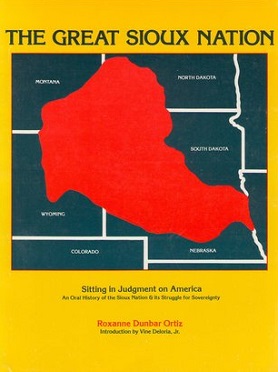The Great Sioux Nation (book) facts for kids

First edition
|
|
| Author | Roxanne Dunbar-Ortiz (ed) |
|---|---|
| Language | English |
| Genre | non-fiction |
| Published |
|
| Media type | Print (Hardback, Paperback) |
| Pages | 224 |
| ISBN | 978-0-8032-4483-2 (2013) |
The Great Sioux Nation: Sitting in Judgment on America is an important book edited by Roxanne Dunbar-Ortiz. It shares the "oral history" (stories told by people) of the Sioux Nation. The book focuses on their fight for "sovereignty," which means their right to govern themselves. It records what happened during a special court hearing in 1974. The information from this hearing has been used to support the rights of Indigenous peoples. This work helped lead to the 2007 Declaration on the Rights of Indigenous Peoples. This declaration protects the rights of native groups around the world.
Contents
About The Great Sioux Nation Book
This book is a collection of stories and facts. It tells about the history and struggles of the Sioux people. The editor, Roxanne Dunbar-Ortiz, brought together many voices. These voices explain the Sioux Nation's long fight for their land and rights. The book helps people understand the challenges faced by Indigenous communities.
What Was the Lincoln Treaty Hearing?
The "Lincoln Treaty Hearing" took place in December 1974. It was held in a US District Court in Lincoln, Nebraska. This hearing was part of many court cases. These cases followed a major event in 1973 called the Wounded Knee Occupation. During the hearing, about 65 people spoke over 13 days. Their stories filled almost 3,000 pages of records.
Many important activists and scholars took part. These included Simon J. Ortiz, Vine Deloria Jr., and Russell Means. They shared their knowledge and experiences. Judge Warren Keith Urbom was in charge of the court proceedings. The hearing aimed to bring attention to treaties. Treaties are agreements between nations. The Sioux Nation had treaties with the US government.
When Was the Book Published?
The book was first released in 1977. A newer version came out in 2013. This new edition includes a fresh introduction by Roxanne Dunbar-Ortiz. It also has a new foreword by Philip J. Deloria. This paperback version has 232 pages.
Voices from the Past
The book includes powerful statements from people who testified. These statements show the deep feelings and history of the Sioux Nation.
Russell Means on Promises
Russell Means, a well-known activist, spoke about broken promises. He said: "We are still waiting on that promise. We put down our weapons in our own country. We did this under our own Treaty. We have brought our people to these courts. We believe that someday, this country will be honest. It will deal fairly with Indian people. I will probably die trying to find that honesty."
Means was talking about the US government's past actions. He highlighted how treaties were often not honored. This caused great hardship for Indigenous communities.
Agnes Lamonte's Story of Wounded Knee
Agnes Lamonte shared a very personal and sad story. She spoke about the site of Wounded Knee. This place is famous for two tragic events. One was a massacre in 1890. The other was the 1973 standoff. She visited her son's grave there. Tourists asked her where Wounded Knee was. She told them:
"This is the church that burned down. The people were inside, and they were shot at. This whole hill is where they gave up. My mother was 12 years old during the 1890 massacre. She told us what happened. She said they surrendered to the government. Then, they started shooting everyone. This included babies, women, and men. I never thought this would happen again. I never thought my son would be next. He is now buried in the Wounded Knee Cemetery. He joked before that he wanted to be buried there. He wanted to be fighting for his people. So, that's where we buried him. My mother's uncle and aunt are also buried there from the 1890 massacre."
Agnes Lamonte's words show the lasting pain and memory of these events. They highlight the importance of remembering history. They also show the deep connection Indigenous people have to their land.

